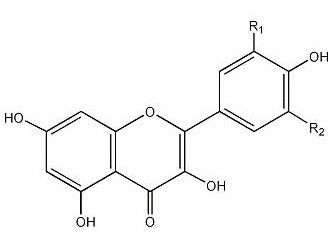Health Benefits of Flavonols
|
Dear Friends,  
We have been illuminating a category of phytochemicals called the Flavonoids over the past three weeks. The Flavonoids subgroups are: anthocyanins, isoflavones, flavanols, flavanones, flavonols, and flavones. We will continue our journey this week unfolding the Flavonols. Flavonols are amongst the most wide spread flavonoids found in foods. There are three main flavonols: quercetin, kaempferol and myricetin. Quercetin is found in cruciferous vegetables, onions, apples, berries, citrus fruits (it’s in the white part on the inside of the peel), seeds and nuts.
The amounts of the flavonols found in fruits, vegetables and beverages varies depending on the varieties, seasonal differences and effects of processing. Quercetin is the most potent antioxidant of the group [and we will focus on its benefit as it is highly studied]. The quercetin glycosides were thought to be poorly absorbed in the GI tract following consumption. However, evidence now indicates that about 50% of quercetin glycosides are absorbed whereas only 25% of the aglycone form is absorbed (Nutritional Genomics, 2011). Health Benefits of the Flavonols
Quercetin is active in many metabolic processes related to diseases of aging, auch as cardiovascular and neurodegenerative disorders. In addition, quercetin also exhibits anti-inflammatory, antiproliferative, and apoptotic effects both on cells in culture as well as when ingested in vivo. Next week we will look at Flavones and Flavanones. Sincerely yours, Seann Bardell Clinical Note: Swollen and bleeding gums, loose teeth, hemorrhaging under the skin, slowly healing wounds, and eventual death. All symptoms of scurvy, the scourge of sailors during the 15th,16th and 17th centuries, until it was recognized as a Vitamin C deficient disease, corrected by adding citrus foods to their diets. Hence, the British label “limey” for their sailors took hold. It was Albert Szent-Gyorgvi PhD/MD in the 1930s who first isolated Vitamin C from Hungarian paprika, indentifying it as ascobic acid, which literally means without scurvy. He also identified a food nutrient or nutients from citrus fruits, that he called Vitamin P (the p for permeability), that decreased capillary fragility and permeability in humans. The name Vitamin P was dropped in favor of the term bioflavonoids, of which the flavonols are an important member. It is important to take Vitamin C along with bioflavonoids for maximizing the health benefits of Vitamin C. For it is the additive and synergistic effects of phytochemicals in fruits and vegetables that are responsible for their potent antioxidant and anticancer activities.
The largest antelope in Africa, the eland is one of the most nervous or skittish animals and take flight at the slightest sign of danger, capable of running for miles without stopping. In southern Africa, three subspecies exist: Cape, Livingstone and East African Eland, and in central and west Africa there is the Giant or Lord Derby Eland. A big eland bull can easily weigh over 2500 lbs. Eland are prolific feeders, browsing in the early morning and late afternoon and sometimes through the night. They are usually found in sparsely wooded savannahs with adequate young trees and shrubs. Eland travel great distances for food, often moving with the seasons and blooming of fruits and flowers.
|
 In the flavonol on the right, Kaempferol has R1=H and R2=H. Quercetin has R1=OH and R2=H. Myricetin has R1=OH and R2=OH.
In the flavonol on the right, Kaempferol has R1=H and R2=H. Quercetin has R1=OH and R2=H. Myricetin has R1=OH and R2=OH. The Last Quiz Answer:
The Last Quiz Answer:
